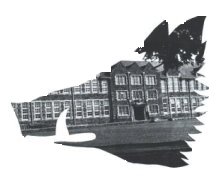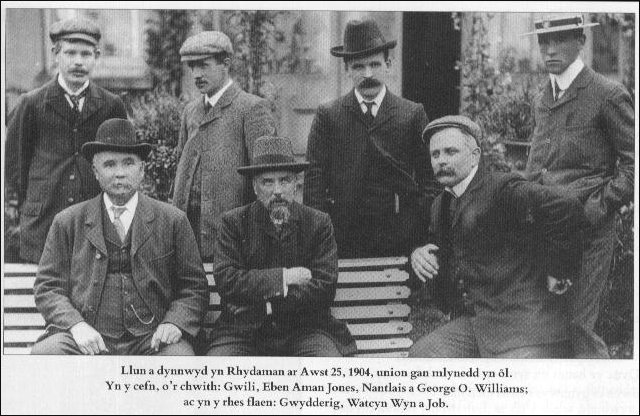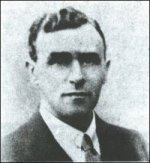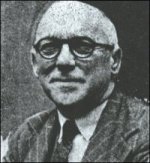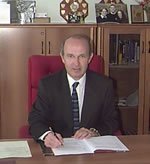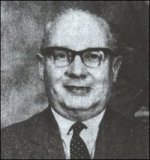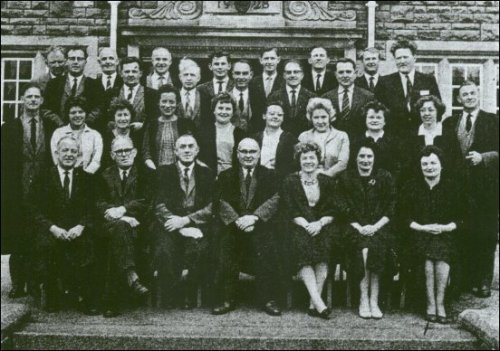The school's logo is 'y twrch trwyth', (the wild boar). The school's motto is "Parched pob byw ei orchwyl", (Let each one respect his task).The story of the struggle to build the first Intermediate (that is, Secondary) school in Ammanford is told in detail in Amman Valley Grammar School – the beginnings in this section of the web site. Briefly, it took almost twenty years for this school to materialise because of objections made by the governors of Llandeilo Intermediate school, built as early as 1896. By that year seven such schools had been built by Carmarthenshire County Council through their 1894 scheme under the Welsh Intermediate Education Act of 1889. These included a reconstituted Grammar School for Boys at Carmarthen, a new Carmarthen Intermediate School for Girls, separate schools for boys and girls at Llanelli, a school for girls at Llandovery, and mixed schools at Llandeilo and Whitland.
The County scheme of 1894 had also provided for an Intermediate school to serve Ammanford and the Amman valley but parents had to wait until 1914 before the scheme produced an actual building where their children could be taught. Until then Ammanford and Amman valley pupils had to travel all the way to Llandeilo to receive their secondary education. As these made up about a third of the pupils of Llandeilo Intermediate School, the governors, not surprisingly, fought vigourously to retain the Ammanford pupils, along with the full complement of staff needed to teach them. Oh, yes – and the headmaster stood to lose one-third of his salary if these pupils left.
In the first years of Amman Valley Intermediate School (later known as the County School) the fears of Llandeilo's powers-that-be might have been justified – Llandeilo had 214 pupils in 1913 but only 145 at the start of term in September 1914 when the pupils living in the Amman Valley area transferred to Ammanford. But in the long term Llandeilo's fears proved to be unfounded. As the author of a 1977 study into the affair points out:
The number of pupils at both schools taken together amounted in 1922 to no fewer than 564, compared with the 214 pupils at Llandeilo alone before the establishment of the Amman Valley School. The experience of less than ten years had clearly demonstrated the need for greatly increased secondary school facilities in this part of Carmarthenshire. (The Welsh Department of the Board of Education and the establishment of a Carmarthenshire Intermediate school: Wynford Davies, National Library of Wales Journal, Vol 20 (1977/78), page 148)
For Ammanford and Amman Valley children wishing to continue their education after the age of 12, there were only two options available until 1914 – either to travel to Llandeilo or to attend Gwynfryn School in Ammanford. Gwynfryn had been opened in 1880 and it survived until 1915 when the newly opened County School just 400 yards away and the shortage of pupils due to the war caused its closure. Also known as 'Watcyn Wyn's school' (after its founder and headmaster William Hezekiah Williams, who took the bardic name of Watcyn Wyn), Gwynfryn was however a private school, for which the pupils' parents had to pay fees. It was thus out of the reach of most families, who could ill afford to pay for school fees and books let alone lose the wages a working son would bring into the household. This was the dilemma facing the parents of Jim Griffiths (1890–1974) a Betws miner who eventually rose to become a cabinet Minister in post war Labour governments:
"At the age of thirteen I had reached the top of the ladder at the Betws Board School – Standard X 7. Already some of my classmates had started work at pit or mill and on Saturdays would swank about their pocket-money. At home I had overheard whispered conversations about my future. Should it be the mine, the tinplate mill, or another school? One of my classmates had found a place at the intermediate school at Llandeilo and we envied him his cap and blazer. My father had his own plan for me. To the coal-mine for a year or so, and then to the Gwynfryn, a school established by Watcyn Wyn, our poet-preacher, to prepare students for the nonconformist ministry. This was the road along which I was to travel from pit to pulpit. But first to the pit as a collier's boy." (Jim Griffiths, Pages from Memory, J M Dent 1969, page 7)
As it happened, Jim Griffiths would not enter Watcyn Wyn's school as planned; economics forced him instead to stay in the colliery until he eventually took the only other route available to a boy from the working class in those days – through the trade union movement, first as a full time agent for the South Wales Miners' Federation in 1925 and eventually on to Parliament in 1936. (For a fuller history of Jim Griffiths, see Jim Griffiths MP and Jim Griffiths – Ammanford Memories in the 'People' section of this website. For more on Watcyn Wyn and Gwynfryn school see Watcyn Wyn, also in the 'People' section).
But when Ammanford finally acquired its school in 1914 it was initially only in temporary buildings on the site of a laundry in Llandybie Road, Tirydail. War had broken out on 8th August 1914 and all thoughts of the larger and permanent building planned for Brynmawr Avenue had to be shelved for the foreseeable future. The school opened its doors to pupils on 29th September 1914 with accommodation for 186 boys and girls and 156 enrolled in the first term. Bryn Roberts will be remembered by many as the scripture teacher in Amman Valley Grammar School. In 1964 he gave his memories of starting school as a boy in Amman Valley County School (as it was then known) in a booklet produced to commemorate the 50th anniversary of the school's foundation in 1914. These are his recollections:
It is ironic that my first memory of the school as a new boy in September 1915, is of picking my way carefully amongst the buckets and pans in the main corridor and then being sent home because the roof leaked so badly. The outbreak of war in 1914 had stopped the building of a new school and temporary premises had to be found. These proved to be very primitive and inadequate, but they were used until 1928.
Another former pupil who remembered conditions at this first school was Donald Peers, who later went on to become Britain's first 'pop idol' long before that term had been invented. Born in Ammanford in 1908, by the 1940s Peers was Britain's highest paid popular singer, with his own radio progamme (and later television programme). His fame became sufficient for him to have his own one-man show at the Albert Hall in 1949. But in 1919 he was just an eleven year old sitting his entrance exam to the County school. Here are his memories of that day, as recalled in his autobiography 'Pathway' published in 1951:
It was an early spring morning when we sat for the examination. Several of us set out together and we walked out of Bettws and over the Ammanford Bridge, through the quiet town. . . past the big overhanging clock in Quay Street, over the square and up along College Street, past Bellamy Villas until we saw some wet roofs of corrugated sheds which were clustered together in an untidy formation. This was Amman Valley County School.
...... It was set back along a clinker-constructed road. Half hidden from the main road, its poverty and ugliness were only apparent when one was very near.
...... This was my first close-up view of the secondary school. I had dreamed that it might be something after the fashion of a fictional grammar school. After all, I had read and lived with Tom Merry, Harry Wharton and Billy Bunter, and I knew Greyfriars inside out, the playing fields, the tuckshop, the quad and the Remove . . what, then, was this collection of shambling army-type huts. . . corrugated and squat with flaking paint peeling from the outer sides.
...... We reported, and hung our caps and lunch packets in the cloakroom. The stench of the cloakrooms made me want to vomit and my natural anxiety and nervousness were not the only reasons why I looked so white. (Pathway, London 1951, pages 41-42)This is also borne out in the memoir of former teacher Mr. A. B. Oldfield Davies, C.B.E., M.A, who was B.B.C. Controller for WaIes in 1964 :
... the temporary premises, though viewed in retrospect through the rosy hue of the years with romantic affection by old pupils, were a serious handicap to the smooth organisation of the school's work and many were the unexpected day's holidays which came in the winter through a failure of the heating system or heavy rain seeping through the classroom roofs.
And finally, the school's third headmaster, O J Evans, corroborated this in his Forward to the 1964 commemorative booklet:
Mr. G. 0. Williams, the first Headmaster, and a small but intrepid band of assistant teachers, set about the formidable task of establishing the School in temporary premises in Tirydail that had previously been used as a laundry. Despite the ramshackle nature of the buildings, they laid down the foundations which resulted in the School developing into a happy community with an active corporate life of its own, and where standards of work and scholarship were of the highest. The First World War and its aftermath caused considerable delay in the provision of new buildings, but these materialised eventually, and the School moved into the present premises on January 23rd 1928. Facilities for work were now first class, and all concerned settled down quickly and happily in their new environment.
The economy of Britain from 1914 to 1918 was devoted, not unnaturally, to the war effort. And in the first few years after the end of war it was devoted to war recovery, so that school building took its place rather low on the list of the nation's priorities. But when the new school arrived in 1928 (see photograph) it was well worth waiting for. A handsome and sturdy stone building – so sturdy it still stands and looks better than more recent additions to the school – it must have seemed like the latest in luxury, for both staff and pupils, after the rather primitive conditions described above by Bryn Roberts and others. The temporary building which opened its doors in 1914 had, after all, taken just six weeks to construct.
The first headmaster in 1914 was G O Williams, the son of the acclaimed 'Watcyn Wyn' (see the page on Watcyn Wyn in the 'People' section of this web site). Mr A B Oldfield Davies, CBE, MA, and BBC Controller for Wales at the time of the 1964 commemorative booklet was a teacher at the time of G O Williams' headship and he remembered G O Williams thus:
Mr. Williams to members of the staff, G. 0. to his friends, George to his intimates, and on occasions Georgic in a familiarly affectionate way to his pupils: that was how the first Headmaster of the Amman Valley Grammar School was known. His appointment in 1914, when the school opened, doubtless owed much to the fact that his illustrious father, Watcyn Wyn, had established and organised for many years a preparatory school in Ammanford which was known all over Wales as Ysgol Watcyn Wyn. It seemed fitting that, when the County School, as it was then known, was established a kind of family succession should be observed. Watcyn Wyn was a poet, a well known public figure, a character, a wit and essentially Welsh. To some extent, the son G. 0. suffered in comparison with his father. He tended to be shy and retiring, he did not like public appearances, he lacked the public gifts of his father and might be said to have been rather reserved in his enthusiasm for things Welsh. G. 0. Williams was more fluent and more at home in English than in Welsh, partly as a result of his upbringing (English being the home-language), partly perhaps in reaction against the fame and reputation of a father whose public gifts had been denied to the son. His attitude to the Welsh language was part of his shyness, his reserve, and implied no lack of pride in his father's achievement or any sense of frustration on his part.
......He was essentially a happy man. He was a very happy Headmaster, happy in his relations with the staff and with the pupils. What he worked for and achieved in overwhelming measure was a happy school. Education in his view was something to be enjoyed, a shared enjoyment for teachers and pupils. He was not a noted disciplinarian; he was never a bustling competent organiser eager to manage a school as if it were a well-oiled machine running silently and smoothly. There were visitors to the school who were surprised at what appeared to them to be disorder or at any rate an apparent lack on the part of the pupils of a sense of the presence of the Headmaster. But then G. 0. Williams did not attach much importance to "presence," his own or anybody else's. He was not concerned to project himself; he never believed in the idea that a Headmaster should be a detached Olympian authoritarian figure whose very appearance was calculated to create an effect. He was always natural and easy, unperturbed and slightly amused. His eyes always carried a smile which frequently broke over the heavy lines and creases of his kindly face. He had a quiet, lively sense of humour which was his effective weapon against a difficult, obstinate or fractious pupil, or even member of staff. He rarely, if ever, issued an order but he had a persuasive kindly way of indicating what he wished done and the affectionate loyalty which he gently commanded ensured that it was done.
...... He was a great lover of books with a well-stocked private library that he was proud of and which he was glad to share with young members of staff by freely lending them books. When the new school was opened in 1928 he was as proud of the school Library as of any feature of the splendid new premises so different from the tin sheds and the annexe "Zion Zinc" which the school had occupied in its early years. Incidentally, the temporary premises, though viewed in retrospect through the rosy hue of the years with romantic affection by old pupils, were a serious handicap to the smooth organisation of the school's work and many were the unexpected day's holidays which came in the winter through a failure of the heating system or heavy rain seeping through the classroom roofs. There was a general air of improvisation which the Headmaster seemed to enjoy. It was aided by his reluctance to decide on a timetable until the school had assembled for a new academic year and for a week or two the issue of a provisional timetable for each day as it came added a spice of unexpectedness to the day's work though it could be disconcerting for a teacher and for a class to find themselves together more frequently than either would wish. No – smooth, well-oiled efficiency was not a quality one associated with G. 0. Williams. He was not an administrator and he would smile quizzically at the notion that "what is best administered is best." He created atmosphere – an atmosphere of trust and tolerance, of good will and loyalty. He had a deep respect for persons as individuals and was always attracted to a pupil with the slightest sign of eccentricity. No one in Ammanford in his day felt constrained or compelled to conform to type. He had no use for a school which turned out recognisable products as if from a mould.
...... In his view a school was not a processing factory or a forcing-bed, but a happy forum or meeting place where boys and girls were encouraged to develop freely, in their own time and at their own pace, whatever gifts they had been endowed with. He was naturally pleased with the success of any boy or girl in the academic or athletic field, but he was not interested in producing results. Nor did he believe that the real achievement of a school could be assessed by quoting statistics. What deeply concerned him was the quality, intellectual, social and personal, of the individuals entrusted to his care. He regarded it as a high privilege to be the first Headmaster of the Amman Valley Grammar School, and my wife and I are no less proud to have been on his staff for a period of years.Some damning with faint praise may be discerned in parts of that memoir but the last paragraph must ring especially true to today's teachers, in an age when statistics and performance-related results are jealous and vengeful gods whom schools neglect at their peril.
Photo: George O. Williams, the first headmaster of Amman Valley Grammar School in 1914, is top row, far right, in this 1904 gathering of local preachers and poets. His father, local poet and educator Watcyn Wyn, is in the middle of the bottom row (a biography of Watcyn Wyn can be found in the 'People' section of the website, or click HERE). Also in the photo are local preacher and poet Nantlais (top row, third from left) at the time of the 1904 Revival (a biography of Nantlais can be found in the 'People' section of this website, or click HERE. Local poet John Jenkins (Gwili) is first left, top row — Gwili can be found in the item on Edward Thomas in the 'People' section, or click HERE. The text below the photo reads: "Picture taken in Ammanford on August 25th 1904, a hundred years ago. In the back, from left: Gwili, Eben Aman Jones, Nantlais and George O. Williams; and in the front row: Gwydderig, Watcyn Wyn and Job." (Photo from Summer 2004 edition of 'Barddas'). The curriculum they decided for the school of 1914 has a decidedly old-fashioned, not to say patronising, look to it these days. The course of instruction would be identical for boys and girls — except that the principal science for boys would be physics, with botany for girls, and boys would take Manual instruction in wood and metal, whilst the girls took cookery, laundrywork, and needlework. It would seem that physics —a 'real' science — was considered more appropriate for boys while botany suited girls better — plants, trees, flowers and the like, subjects just as appropriate to poetry and other 'feminine' pursuits, perhaps. But at least girls were admitted to the county-run schools, unlike Watcyn Wyn's earlier boys-only school in Ammanford.
AMMAN VALLEY GRAMMAR SCHOOL HEADMASTERS
(five since 1914)Clockwise from top left: G. O. Williams (1914-1930), D. Davies Jones (1931-1954), O. J. Evans (1954 -1976), R.O.P. Jones O.B.E. MSc. (Oxon) (1992-2006). There is no photo for C. Edwards (1976 -1992).
We have a description of the school in 1931, the year Mr. D Davies Jones took office after the sudden death of G O Williams in 1930. In 1964 Mr D Davies Jones remembers:
The school building was then only three years old, and the 14 years in the old temporary buildings in Tirydail in which so much good work had been done, but a memory. But conditions were very different from what they are today. There were 360 pupils, of whom only about a quarter received free education, as the percentage of free places was only 25%. The remainder paid a fee of 30 shillings [a term] and all pupils had to buy their own text books and pay their own travelling expenses by train or bus.
......It was a period of industrial depression in the country generally and there was considerable unemployment in the school area. I remember that a considerable part of the time at Governors' meetings was taken up in the allocation of Bursaries and bus fares to deserving cases from a grant made by the Education Committee for the purpose. Even then there were cases of leavers on economic grounds.
...... Usually there was a two form entry of 70 pupils, but as the Free Place percentage increased to 50% and later still to 100% there was increased pressure for admissions, and it was decided to have a three form entry. The first increase in staff for this purpose was granted by the Education Committee in 1932, and the person appointed to this post was Mr. 0. J. Evans, who has been at the school ever since (apart from a period during the war on National Service), and has been the Headmaster for the last 10 years. From 1933 onwards the entry varied from 100 to 90 according to the varying dictates of the Ministry of Education with unfortunate results for candidates in different years. It also led eventually to an overcrowded school with 570 pupils, two forms without their own classrooms and classes in the school hall and dining room. After much pressure by the Governors and an inquiry at Carmarthen, plans were made for additional buildings on the extra land which had been purchased for the purpose, but the second World War came in 1939.
...... In 1940, with the use of the school by the Roan Boys School, Greenwich, partly on a shift basis, and also girls from the Roan Girls at Tirydail, and from the Addey and Stanhope School at Garnant for Science classes on odd afternoons and Saturdays, there were about 820 pupils using a school built for 350. After the war, economy was the watchword for some years, but the extra land came handy for building the new school canteen (we grew potatoes, etc., on it during the war), and although promises were made that a start would be made on the planned extensions at any moment, they were not forthcoming until recently.It can come as a bit of a surprise to find out that the school in 1914 did not have free entry to all pupils. We see that in 1931 only 25% of pupils enjoyed that privilege and it wasn't until the post war Labour Government created the modern Welfare State that free secondary education for all became a universal right, and not a privilege decided by the allocation of bursaries (i.e., discretionary grants).
The old building in Tirydail had a chequered history after 1928 until 1976 when a fire put paid to its life. From 1919 a summer mining school was established at the school for the training of mining officials. This proved so successful that a specialist Mining and Technical Institute (later renamed Ammanford Technical College) was established when the YMCA building in Iscennen Road closed and the mining school transferred there in 1927.
The Tirydail building was leased for a while to the Ministry of Labour for use as a juvenile unemployment centre for the purpose of retraining unemployed youth during the depression years. For a comment on the success – or otherwise – of this venture you may care to read the memories of one of the youths 'retrained' there. This will be found under The Miner's Tale in the 'People' section of this web site and shows, if it shows anything at all, the gap that all too often exists between the intentions of the educators and the reality for those educated by them.
As we have seen above, the Tirydail school was occupied from 1939-45 by the girls of Roan School, Greenwich, London, who were evacuated to Ammanford for the duration of the war. The evacuated boys of the same school went to the new building in Church Street, with classes being held in shifts!
Later the Tirydail building was used as an annexe for Amman Valley Secondary Modern School, High Street, which had been built in 1926. Pupils who did woodwork and metalwork had to walk from High Street to the Tirydail building which housed the workshops for these subjects. The 'annexe' was also used through the fifties and sixties as a Youth Club in the evenings.
In 1974 the building was sold to the newly created Dinefwr Borough Council and until 1976 it was leased by a company making fibre glass products – Fibremould Ltd. The building was, however, destroyed by a fire in 1976 and a sheltered housing complex was eventually built in 1981, named Nantlais after the long-serving minister of Bethany Methodist Chapel, Wind Street (see the page on Nantlais in the 'People' section of this web site.).
The new school of 1928 has also seen several changes since its creation. As we saw in the memoir of second headmaster Mr. D Davies Jones above, by 1939 there were plans to extend the site which had to be shelved, again due to the outbreak of war. In 1945 when war ended the only change that took place was in the name of the school, which became Amman Valley Grammar School. The final extensions and upgrades came only in 1960 when the old building received renovations and a new block was built at the side of the original stone building. If memory serves right, this comprised new classrooms for the fourth and fifth forms along with new chemistry and physics laboratories, new woodwork and metalwork workshops, a new art room and library.
Mr O J Evans again:
Expansion in the number of pupils admitted began to create accommodation difficulties as early as the middle thirties, and these were enormously accentuated by having to share the premises with a number of evacuated schools during the Second World War. There were also grave staffing problems during the war-time period....
...... Our aspirations for improvements in accommodation, staffing, organisation and curriculum were all realised in time for the session commencing in September 1960. Thanks to the active support of the Governors and the full co-operation of the Carmarthenshire Education Committee, a large new extension to the existing building was planned, built, and equipped. Major modifications inside the old building were also completed, and contracts allocated to bring the electrical and heating systems up to modern standards. Additional teachers were appointed, and it became possible to achieve a complete reorganisation of form structure which permitted all pupils to follow a graduated five year course up to Ordinary Level. The new timetable introduced offered a wider choice of subjects at Ordinary and Advanced Levels, and it also became possible to divide large classes in the Sixth Form.....
...... There are now [ie, in 1964] 643 pupils on the roll, of whom 138 are pursuing specialised courses in the Sixth Forms.
Amman Valley Grammar School Staff in the fiftieth anniversary year of 1964:
Back row: Mr. H. Jones, Mr. W. T. Phelps. Mr. G. Adams. Mr. E. P. Rees, Mr. E. S. George, Mr. W. B. Jenkins, Mr. R. W. Garrero, Mr. H. M. Evans, Mr. T. A. Walters, Mr. J. R. Evans, Mr. J. W. Hopkins, Mr. D. Williams, Mr. J. E. Williams, Mr. B. Samways.
Second row: Mr. A. C. Rees, Mrs. M. Williams, Mrs. M. A. Williams, Mrs. M. M. Williams. Mrs. S. N. Rees, Miss C. F. Prout. Miss D. M. Evans, Miss M. D. Jones, Miss E. F. Butcher, Mr. T. K. Lewis.
Front row: Mr. B. Roberts. Mr. LI. Williams, Mr. 0. Evans. Mr. 0. J. Evans, Mrs. E. A. Edwards. Mrs. N. Adams. Miss M. Mainwaring.Then in 1970 came the largest change of all when Carmarthenshire County Council adopted a policy of comprehensive schools and the abolition of the eleven plus. A much larger complex was built, with its main entrance in Margaret Street to house the extra intake of the old secondary modern school. This saw new classrooms, gym and assembly hall. Also built was a new cinder running track to replace the grass track that was temporarily marked out for school sports each summer on the secondary modern's rugby pitch. The new Amman Valley Comprehensive School, as it was now called, also acquired a brand new indoor swimming pool, available to the public during out-of-school hours and school holidays. All these extra buildings and facilities were most necessary as the new Comprehensive grew from the 600 pupils of the grammar school to almost three times that after its merger with the secondary modern.
The moving finger writes, and having writ, moves on, or so claimed the Persian poet Omar Khayyam. Times
change, nothing stands still, and the school was renamed again in 2000 when it acquired the shorter appellation of Amman Valley School (Ysgol Dyffryn Aman). That, for now at least, is that, though no doubt our politicians, in their never-ceasing desire to inflict as much confusion on as many people as possible, will not let matters rest there. These are tumultuous times for the teaching profession and the pupils they serve. The shades of those early teachers in Amman Valley Intermediate School, if they are watching, wouldn't recognise their profession today, so much has it, and society, changed since 1914. Just the paper work and bureaucracy that are showered on the modern teacher would render the trade they once plied unrecognisable to their curious gaze.
Whether it's called Amman Valley Intermediate, Amman Valley County, Amman Valley Grammar, Amman Valley Comprehensive or just plain Amman Valley School, crystal balls alone can see what lies in store for today's teachers and their school, so it's probably for the best that none of them has the faintest idea what that future is. No more; where ignorance is bliss, 'tis folly to be wise, said another poet, and that's where matters had better rest for now.
To see all the pupils and staff in the 1959 school photograph, click Here
The school has its own web site on: http://www.ammanvalley.ik.org
If anyone wishes to read a complete text version of the 1964 commemorative booklet click on AVGS 1914-1964
Sources:
'The Welsh Department of the Board of Education and the establishment of a Carmarthenshire intermediate school': (Wynford Davies, Journal for the National Library of Wales, Vol 20, 1977/78, pages 131 - 150)
'Amman Valley Grammar School: The First Fifty Years (1914-1964)', (Carmarthenshire Education Authority, 1964)END NOTE:
The provision of education in the Llandybie, Ammanford and Betws area has a long history, going back at least 270 years from the first circulating schools of Griffith Jones in 1731. This history is too long and detailed to be encompassed by one essay so it has had to be divided into several sections. And even this does scant justice to the rich and complex subject matter. It awaits a far more competent historian than the present author and will have to be far more scholarly than this patchwork quilt of a web site will allow. Still, we can but try. The various sections are:Education in Ammanford 1
Education in Ammanford 2
Amman Valley Grammar School from 1914 to the present
Amman Valley Grammar School – the beginnings
Betws Primary School
Ammanford Technical College
Gwynfryn College ('Watcyn Wyn's School')
Date this page last updated: August 24, 2010
